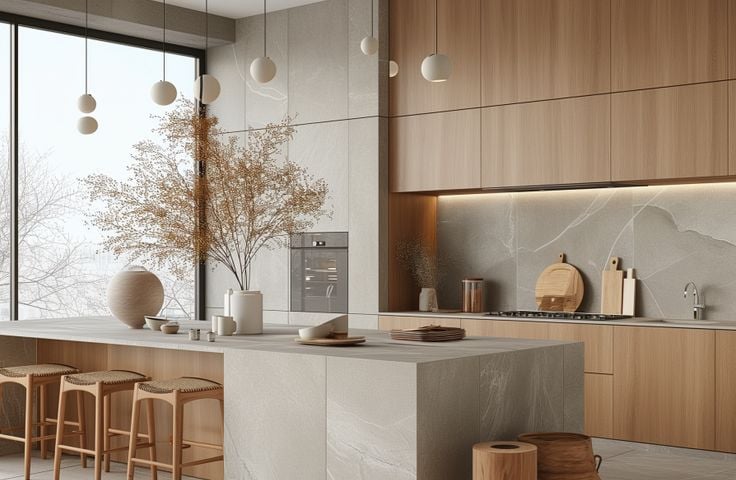Designing Your Dream Kitchen: Six Proven Strategies for Functional and Aesthetic Brilliance
The kitchen is the heart of every home, where functionality meets beauty. This guide shares six key strategies for designing a dream kitchen, including efficient layouts, smart storage, durable materials, and personalized touches. Let Fingertouch Interior create a space that’s both practical and stunning, tailored to your needs.
12/16/20243 min read


The kitchen remains the main part of modern living—a space that bridges practicality and aesthetics together. It serves as the embodiment of spatial functionality, ergonomic efficiency, and enduring design.
This guide presents six strategies to balance design excellence with operational performance. Whether you are a homeowner or a professional designer, these principles offer actionable solutions to create spaces that are as efficient as they are beautiful.
1. Optimized Spatial Layout: The Foundation of Functionality
Effective kitchens hinge on deliberate spatial design planning to better manage the space. The work triangle for the kitchen comprised of the sink, stove, and refrigerator this is the most important part of the kitchen, and the layout is planned across them. Here are some of the layout ideas.
U-Shaped Kitchen: it has a storage-centric layout. use to get the maximum storage space, usually used in apartments or closed kitchens.
L-Shaped Kitchen: It has a modern look and is mainly found in open kitchens. It is easily adaptable and customized even after completion.
Galley configurations: It is usually used when there is a small area in the kitchen where you can work. It's a parallel placement of the cabinets from each, with about a three to five-foot walk area between them.
Islands Kitchen: Kitchen islands are freestanding cabinets or tabletops that are accessible from all sides. It can be used as a storage unit to store utensils or even as a dining table. one can enjoy.
Introduction ergonomic pathways will help to reduce the physical strain on the clients and make working in the kitchen more fun. How does the ergonomic pathway work here is a simple example: the kitchen should have a triangle layout of the sink, refrigerator, and stove. the sink must be close to the refrigerator and in the same line, and the stove should be on the opposite side.
for further inquiries, check us out for a comprehensive ergonomic pathway for your kitchen
2. Intelligent Storage Systems: Form Meets Function
One of the major uses of the kitchen is to store all items, from crockery to edible items, and often, this dictates the kitchen's usability. Here are some smart storage solutions to make your kitchen more usable and easy to navigate through.
Space-Saving Features: Pull-out shelves, tiered cabinetry, and modular compartments.
Vertical Solutions: Overhead racks, integrated appliance garages, and deep pantries.
Creating a custom cabinet as per your requirements for spices and tools helps to better manage, and this, in turn, will help in spatial clarity and reduce cognitive load while fostering ease of access.
3. Material Selection: Durability and Timeless Aesthetics
Material integrity defines the longevity and elegance of a kitchen. Prioritize surfaces and finishes with enduring resilience:
Counters: For the counter, it is preferred to use a super durable and stain-resistant platform and the best thing that comes into mind when thinking of this type of material is Engineered quartz or natural granite they are strong and durable.
Cabinets: Use Solid wood or MDF with laminated finishes to deliver structural stability and aesthetic flexibility and affordable MDF is especially more affordable than solid.
Flooring: Porcelain tiles or hardwood strike the perfect balance between durability and design continuity.
Strategic material choices create kitchens that retain their beauty and functionality for decades.
4. Layered Lighting: Enhancing Ambiance and Usability
Lighting serves as both a functional necessity and a design element. A layered approach ensures visual harmony:
it creates an ambiance in the kitchen. The use of recessed lights or chandeliers for illumination of the environment
Ambient: Recessed lighting or chandeliers for general illumination.
Task Lighting: Under-cabinet LED strips to ensure visibility for specific tasks.
Accent Features: Pendant lights or architectural uplighting highlight focal design elements.
Layered illumination fosters safety, functionality, and aesthetic depth.
5. Appliance Integration: Harmonizing Design and Technology
Modern kitchens seamlessly integrate appliances into the design scheme:
Built-In Appliances: Streamline the appearance with integrated ovens, refrigerators, and dishwashers.
Smart Features: IoT-enabled systems enhance energy efficiency and convenience.
Ergonomic Placement: Ensure appliances are positioned intuitively to improve user flow.
Integrating technology at the design stage enhances spatial harmony while minimizing retrofitting costs.
6. Personalization: Imbuing the Space with Identity
A kitchen should reflect its owner’s lifestyle while adhering to universal design principles:
Color Psychology: Neutral palettes with accent tones evoke warmth and sophistication.
Hardware and Fixtures: Unique handles, artisanal finishes, and statement faucets add personal flair.
Decorative Utility: Open shelving, tactile surfaces, and indoor greenery merge function with aesthetics.
Customization transforms a functional space into an expression of individuality.
At Fingertouch Interior, we specialize in crafting bespoke kitchen spaces that unify spatial efficiency, material excellence, and personalized style. Our expert team ensures that every element—from concept to execution—delivers an enduring transformation.
Contact us today for a consultation and let us bring your dream kitchen to life.
Built-In Appliances: Streamline the appearance with integrated ovens, refrigerators, and dishwashers.
Smart Features: IoT-enabled systems enhance energy efficiency and convenience.
Ergonomic Placement: Ensure appliances are positioned intuitively to improve user flow.
Integrating technology at the design stage enhances spatial harmony while minimizing retrofitting costs.

© 2024. All rights reserved.
IT SOLUTIONS SERVICES
COMMON LINKS
Office No 207 2nd Floor - Sheikh Mohammed Bin Rashid Al Maktoum Charity Building- Al Nahda - Al Nahda 2 - Dubai
GET IN TOUCH
INTERIOR DESIGN SERVICE
CONTACT US


Design & Fit-out Team: +971 589000893
EMAIL US: info@fingertouchinteriorsgroup.ae


IT Solutions Team:+971 542475712
Eng.Rashid Al Hammadi :+971 558899089


